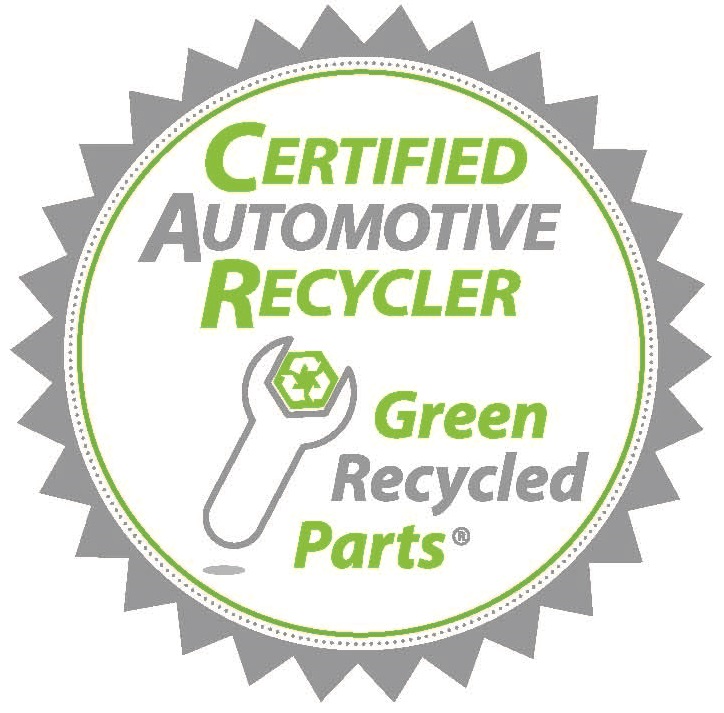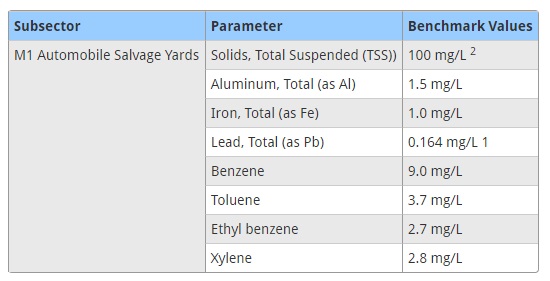While we have tried to present a summary of the essential information on this topic, you should be aware that other items, such as local regulations, may apply to you. Please read the disclaimer.
What You Need to Know
The Clean Water Act requires virtually every automotive salvage or recycling operator to obtain a stormwater permit (with very few exceptions to this rule). Therefore, if you own or operate an automotive salvage facility you are required to maintain a stormwater permit. Rain or snow falling on your property can pick up contaminants as it runs off, and can carry the contaminants through drainage systems directly into streams, rivers, and lakes. The term "stormwater" refers to this type of runoff.
Stormwater permits are required because stormwater that comes in contact with metals, oil and grease, used batteries and tires, and other materials common at automotive recycling facilities may cause pollution that can affect the local community's ability to swim and fish in lakes, rivers, and streams. For example, the mercury that still may be found in old automotive switches is toxic to humans and to the fish they may catch and eat. By taking some common sense actions under the stormwater permit to prevent stormwater contamination, you can provide your community with environmental benefits to compliment the value of recycling end-of-life vehicles.
Regulations
In 1987, Congress mandated that "industrial" sites obtain stormwater permits through the National Pollutant Discharge Elimination System or NPDES program. In 1990, EPA defined "industrial" to include, among many other types of sites, "salvage yards and automotive recyclers." [Title 40 CFR 122.26(b)(14)(vi)].
What is NPDES?
The NPDES permit program addresses water pollution by regulating point sources that discharge pollutants to waters of the United States. EPA authorized state agencies to perform NPDES or stormwater permitting, administrative, and enforcement aspects of the program.
In Minnesota, the stormwater program is administered by the Minnesota Pollution Control Agency (MPCA). The automotive recycling, dismantling, or salvage industry is covered under the National Pollutant Discharge Elimination System (NPDES) industrial general permit. General permits reduce the amount of time and paperwork involved in obtaining a stormwater permit.
A storm water pollution prevention plan (SWPPP) is required for all storm water permits. The plan must be completed prior to submitting the stormwater permit application known as the "Notice of Intent." The plan should be kept on-site at the facility or construction site that generates the storm water discharge.
Minnesota Auto recyclers must:
Obtain an NPDES stormwater permit (MNG610000) by submitting an application form to MPCA
MPCA
Industrial Division
Industrial Stormwater Permit Program
520 Lafayette Road North
St. Paul, MN 55155-4194
Do not enclose any application fee payment. You will receive an invoice from the MPCA for annual stormwater fees in April each year. Currently, the annual fee is $400.
Facilities that discharge through a Municipal Separate Stormwater Sewer System (MS4) must also have a permit.
Develop and implement a stormwater pollution prevention plan (SWPPP).
The following information must be included in the SWPPP.
Drainage map for the facility
List of significant materials that may pollute stormwater at the facility
List of Best Management Practices that will address potential stormwater pollutants at the facility
Preventive maintenance program and spill prevention and response procedures
For more information on SWPPP content, go to the Minnesota Pollution Control Agency (MPCA) Web site. https://www.pca.state.mn.us/water/industrial-stormwater
Your SWPPP must include a description of potential sources of stormwater pollution and measures and controls, including best management practices (BMPs) that will be implemented at your facility to prevent or minimize stormwater contamination. When developing the SWPPP, you must consider the use of certain BMPs that EPA and DNR consider applicable to specific areas such as vehicle dismantling/storage areas and fluids storage areas. However, you do not need to limit yourself to just these BMPs.
For more specific information on developing a Pollution Prevention Plan, download the ECAR SWPPP Fact Sheet.
Exceptions. Under the conditional no exposure exclusion, operators of industrial facilities in any of the 11 categories of "storm water discharges associated with industrial activity," (except construction activities, which are addressed under the construction component of the NPDES Storm Water Program) have the opportunity to certify to a condition of "no exposure" if their industrial materials and operations are not exposed to storm water. As long as the condition of "no exposure" exists at a certified facility, the operator is excluded from NPDES industrial storm water permit requirements.
Sampling Requirements
Quarterly sampling began on July 1, 2015, for a minimum of 4 quarters, according to the dates below:
- Quarter 1: July, August, September 2015 (SWMR form was due no later than October 21, 2015)
- Quarter 2: October, November, December 2015 (SWMR form was due no later than January 21, 2016)
- Quarter 3: January, February, March 2016 (SWMR form was due no later than April 21, 2016)
- Quarter 4: April, May, June 2016 (SWMR form was due no later than July 21, 2016)
After Quarter 4: Calculate your 4 quarter average for each monitoring parameter and compare to the permit benchmark values
Averages from last 4 quarters’ of results above the benchmark? Keep sampling.
Below the benchmark? You are done monitoring for that parameter until April 5, 2020.
- Quarter 5: July, August, September 2016 (if sampling was still required, SWMR form was due by Oct 21, 2016)
After Quarter 5: Calculate your new 4 quarter averages (Quarters 2-5)
Averages from last 4 quarters’ of results above the benchmark? Keep sampling.
Below the benchmark? You are done monitoring for that parameter until April 5, 2020.
- Quarter 6: October, November, December 2016 (if sampling is still required, SWMR form is due by Jan 21, 2017)
After Quarter 6: Averages from last 4 quarters’ of results above the benchmark? Keep sampling.
Below the benchmark? You are done monitoring for that parameter until April 5, 2020.
Submit your sampling results on your facility-specific SWMR form. To download and fill out the form, go to the Industrial Stormwater Permit Information Access website and type in your Permit ID number or facility name. Use this handy “Industrial Stormwater Sampling Worksheet” to record and review your sampling data.
Frequently-asked questions:
What if I didn’t collect samples during four separate quarters?
Continue attempting to sample. Be sure to submit a SWMR form with either your sample results or a “no sample collected” explanation.
I have to sample for 2 parameters. For my averages, I passed one and exceeded the other.
Do I have to resample for both parameters? What should I record on the sampling form?
You no longer need to sample for the parameter that passed. Indicate “passed” for that parameter to let us know you no longer have to sample for it, and continue sampling for the remaining parameter.
What if I am below the permit benchmark values for all the parameter(s) at all of the monitoring location(s)?
Great! You are done monitoring until April 5, 2020; you do not need to notify the MPCA that you’re “done” with the sampling requirements. Monthly inspections, annual reports, and annual fees are still required. Keep the monitoring results documented in your Stormwater Pollution Prevention Plan.
Industrial Stormwater Technical Staff:
Southern half of state: Dave Bodovinitz
10-county Metro/general question: Melissa Wenzel
North half of state: Mary West
Self-Audit Checklist
An inspector may check the facility for compliance with environmental regulations. Conducting a "self-audit" will identify and correct problems before they result in penalties.
Use the following list to audit your stormwater permit:
- Does your facility have a stormwater permit? Verify that your facility has a current stormwater permit issued by the Iowa DNR if your facility falls under the requirement.
- Has your facility developed and implemented a stormwater pollution prevention plan or SWPPP? Verify that a SWPPP has been prepared and is available on-site for inspection. Review the plan and verify that BMPs have been implemented. Note: If the facility is inspected, the SWPPP will be checked against all requirements in the permit. It is required that all SWPPPs be fully compliant with the permit.
- Does your facility have a stormwater monitoring program? Review your records to verify that visual observations and sampling have been performed.
Best Management Practices (BMPs)
Most regulations tell you what you have to do to be in compliance, but they don't explain how to do it. That's where "best management practices" come into play. BMPs are proven methods that help you to get into compliance and stay there. The following BMPs are recommended for stormwater pollution prevention.
The following is a list of BMPs for auto salvage facilities identified by EPA when the stormwater regulations were published:
Dismantling and vehicle maintenance:
- Drain all fluids from vehicles upon arrival at the site. Segregate the fluids and properly store or dispose of them.
- Maintain an organized inventory of materials used in the maintenance shop.
- Keep waste streams separate (i.e. waste oil and solvents). Non-hazardous substances that are contaminated with hazardous substances are considered a hazardous waste.
- Recycle antifreeze, gasoline, used oil, mineral spirits and solvents.
- Dispose of greasy rags, oil filters, air filters, batteries, spent coolants and degreasers properly.
- Label and track the recycling of waste material.
- Drain oil filters before disposal or recycling.
- Store cracked batteries in a nonleaking secondary container.
- Promptly transfer used fluids to the proper container.
- Do not pour liquid waste down floor drains, sinks or outdoor storm drains.
- Plug floor drains that are connected to the storm or sanitary sewer. If necessary, install a sump that is pumped regularly.
- Inspect the maintenance area regularly for proper implementation of control measures.
- Filter stormwater discharges with devices such as oil-water separators.
- Train employees on proper waste control and disposal procedures.
Outdoor vehicle, equipment and parts storage:
- Use drip pans under all vehicles and equipment waiting for maintenance and during maintenance.
- Store batteries on impervious surfaces. Curb, dike or berm this area.
- Confine storage of parts, equipment and vehicles to designated areas.
- Cover all storage areas with permanent cover (roof) or temporary cover (canvas tarps).
- Inspect the storage yard for drip pans and other problems regularly.
Vehicle, equipment and parts washing areas:
- Avoid washing parts or equipment outside.
- Use phosphate-free biodegradable detergents.
- Consider using detergent-based or water-based cleaning systems in place of organic solvent degreasers.
- Designate an area for cleaning activities.
- Contain steam cleaning washwaters or discharge under an applicable NPDES permit.
- Ensure that washwaters drain well, and are not draining into a MS4 or surface water body.
- Do not discharge wastewater into a dry well.
- All discharges authorized by the general stormwater permit must fully meet all applicable water quality standards.
- Inspect cleaning area regularly.
- Install curbing, berms or dikes around cleaning areas.
- Liquid storage in above ground containers:
- Maintain good integrity of all storage containers.
- Install safeguards (such as berms) against accidental releases in the storage area.
- Inspect storage tanks to detect potential leaks. Perform preventative maintenance.
- Inspect piping systems for failures or leaks.
- Train employees on proper filling and transfer procedures.
Improper connection with storm sewers:
- Plug all floor drains if it is unknown whether the connection is to storm sewer or sanitary sewer. Alternatively, install a sump that is pumped regularly.
- Update facility schematics to accurately reflect all plumbing connections.
- Install a safeguard against vehicle washwaters and parts cleaning water entering the storm sewer unless permitted.
- Maintain and inspect the integrity of all underground storage tanks; replace when necessary.
Contacts
For general permit questions, contact the Industrial Stormwater General Permit Administrative Lead at 651-297-7068
Related ECAR Fact Sheets
For more specific information on developing a Pollution Prevention Plan, download the ECAR SWPPP Fact Sheet.
ECAR Fact Sheet Minnesota STORMWATER
Fact Sheet Status and Disclaimer
The following compliance assistance information for the state is subject to all of the warranties and disclaimers associated with this internet website [Read full disclaimer]. Please note that this information has been submitted or will be submitted to the state agencies responsible for implementing environmental laws and regulations for their review and comment. This note is provided only for your informational purposes and does not change or alter any warranties or disclaimers, including, for example, your responsibility to seek appropriate legal or technical assistance to interpret the state's laws as needed.
Stormwater Resource Locator
All vehicle dismantling facilities in the United States (except those in a combined sewer service area or facilities that do not discharge stormwater from their property) are required by the Clean Water Act to obtain a stormwater permit either from the U.S. Environmental Protection Agency or from an appropriate state agency. For more information on EPA’s stormwater regulations, please see: https://www.epa.gov/npdes
Federal EPA National Pollutant Elimination Discharge System (NPDES) Stormwater Regulations. EPA defines automobile salvage yards and scrap recycling facilities as industries eligible to use the multi-sector general permit (MSGP).
Sector M: Auto Salvage Yards
Included in this permitting process are requirements to file a Notice of Intent (NOI) with the appropriate state agency and to prepare a Storm Water Pollution Prevention Plan (SWPPP) to describe how you will address your facility’s stormwater issues.
The fact sheets are designed to assist automotive recyclers with operating their businesses and managing their wastes in compliance with the environmental laws in Iowa. ECAR tries to provides timely and essential information on this topic, but be aware that other items, such as local regulations and recent changes, may apply. Read the Disclaimer. To view other Minnesota FACT SHEETS return to the ECAR Virtual Tour.
MPCA Notice sent 1-6-2017
Dear Industrial Stormwater Permittee:
The 2016 annual report is available! Annual Reports for the 2016 calendar year is due on March 31, 2017. Here are links to the 2016 Annual Report and Newsletter/instructions:
- - Annual Report: You can email either the MS Word or PDF version to us at iswprogram.pca@state.mn.us or mail a paper copy to us at the address on the form. If you need a hard-copy version mailed to you, please contact us at the Stormwater Hotline at 651-757-2119 or 800-657-3804 (non-metro only).
- - Newsletter/instructions: https://www.pca.state.mn.us/sites/default/files/wq-strm3-66a.pdf
The following items are where we see the most reporting errors from year to year; please make sure you properly address these sections: monthly inspections are incomplete for all 12 months (or all months of active permit coverage), annual ISW training date(s) missing/left blank, failure to provide annual review of impaired waters list Hint: we provide the link to help you determine this in the annual report.
Mark your calendars for the Industrial Stormwater next training sessions:
- January 31, 2017 at the MECA pre-conference events at the Verizon Wireless Center in Mankato, MN. This half-day session will address SWPPP modifications due to benchmark monitoring test result exceedances. Register at http://mnerosion.org/
- March 7, 2017 at the MNDOT Training Facility in Arden Hills, MN. This day-long session will cover permit basics, SWPPP development and implementation and stormwater monitoring and reporting requirements. For additional information or to register, please visit the U of M Erosion and Stormwater Management Certification Program’s website
- May 10, 2017 at the MNDOT Training Facility in Arden Hills, MN. This half-day session will address SWPPP modifications due to benchmark monitoring test result exceedances. For additional information or to register, please visit the U of M Erosion and Stormwater Management Certification Program’s website
Winter stormwater management practices
We know it rains in the winter and brief warm temperatures produce snow melt conditions. Now that winter is here, winter stormwater management practices are here to stay. Salt and sand will help prevent keep people and drivers safe, but need to be used appropriately. Preventing ice build-up and keeping up with shoveling and snow-blowing will save you time, money, and help the environment in the long run. Mississippi Water Management Organization (MWMO) put out an excellent article about practical tips, suggestions, do’s and don’ts for winter (frozen) stormwater management. Check out the “How to Fight Snow and Ice Without Polluting” article, courtesy of MWMO staff.
Sampling Requirements: are you required to collect samples of your industrial stormwater runoff? We’ve sent the same message to permittees for nearly 2 years: all permittees are required to collect a minimum of 1 set of samples per quarter over at least 4 separate quarters. If results average below the permit benchmark value(s), you no longer have to collect stormwater samples. MPCA staff are currently analyzing which facilities have not sent in sampling forms, either with sampling results or a “no flow” explanation.
- It is a violation if you do not attempt to collect a sample in a required sampling quarter.
- It is a violation if you fail to send in a sampling form in a required sampling quarter.
For more information, Visit Step 9: Sampling. Please contact technical staff at: iswprogram.pca@state.mn.us or call 651-757-2119 or 800-657-3804 (non-metro only) for facility-specific assistance or to assess whether or not you are required to continue sampling requirements.
We hope this courtesy message about annual reports, training, sampling, and winter BMP maintenance is helpful. From all of us from the Industrial Stormwater Program: happy New Year to you!
Melissa Wenzel
Industrial Stormwater Program Coordinator
651-757-2119 | iswprogram.pca@state.mn.us




